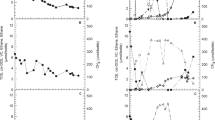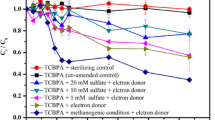Abstract
Monosubstituted nitro- and aminophenol isomers exhibited limited biodegradability under methanogenic conditions when supplied as the sole source of carbon and energy. This was examined by supplying to the same sediment samples, each isomer of nitro- and aminophenol as a sole source of added carbon under either N-supplemented or N-deprived methanogenic conditions. The results demonstrated that under N-supplemented conditions, only 2-NP (NP=nitrophenol), 4-NP and 4-AP (AP=aminophenol) were stoichiometrically mineralized, 2-AP, 3-AP, and the 3-AP metabolite formed from 3-NP reduction were persistent over the 51-week incubation period. In addition, NP isomers inhibited initial rates of methanogenesis, while all AP amended cultures exhibited no significant inhibition in the rate of methanogenesis. Under N-deprived conditions, 2-NP, 2-AP and 4-AP were mineralized, while 3-NP, 4-NP and 3-AP were persistent over the 51-week incubation period. Although all NP isomers were still metabolized through the corresponding AP isomer, the deprivation of nitrogen significantly depressed both the rate and extent of methanogenesis. In general, nitrogen supplemented cultures produced 25% more methane than the nitrogen limited cultures, and the initial rates of methanogenesis were four times greater. While these data showed that under N-deprived conditions methanogenesis was inhibited to a greater extent by these compounds, it also suggests that N-deprived conditions may have facilitated the establishment of a 2-AP metabolizing consortium.
Similar content being viewed by others
References
Battersby N, Wilson V (1989) Survey of the anaerobic biodegradation potential of organic chemical in digesting sludge. Appl Environ Microbiol 55:433–439
Boyd SA, Shelton DR, Berry D, Tiedje JM (1983) Anaerobic biodegradation of phenolic compounds in digested sludge. Appl Environ Microbiol 46:50–54
Boyd SA, Shelton DR (1984) Anaerobic biodegradation of chlorophenols in fresh and acclimated sludge. Appl Environ Microbiol 47:272–277
Fedorak PM, Hrudey SE (1988) Anaerobic degradation of phenolic compounds with application to treatment of industrial wastewaters. In: Wise D (ed) Biotreatment systems. CRC Press, Inc, Boca Raton, FL, pp 169–225
Horowitz A, Shelton DR, Cornell CP, Tiedje JM (1982) Anaerobic degradation of aromatic compounds in sediments and digested sludge. Dev Ind Microbiol 23:435–444
Johnson LD, Young JC (1983) Inhibition of anaerobic digestion by organic priority pollutants. J Water Pollut Control Fed 55:1441–1449
Krieg NR (1981) Enrichment and isolation. In: Gerhardt P, Murray RGE, Costilow RN, Nester EW, Wood WA, Kreig NR, Briggs G (eds) Manual of methods for general bacteriology. American Society for Microbiology, Washington, DC, pp 112–142
Kuhn EP, Suflita JM, Rivera MD, Young LY (1989) Influence of alternate electron acceptors on the metabolic fate of hydroxybenzoate isomers in anoxic aquifer slurries. Appl Environ Microbiol 55:590–598
McBride BC, Wolfe RS (1971) Inhibition of methanogenesis by DDT. Nature 234:551–552
Moat AG (1979) Microbial physiology. John Wiley and Sons, NY, 283 pp
O'Connor OA, Young LY (1989) Toxicity and anaerobic biodegradability of substituted phenols under methanogenic conditions. Environ Toxicol Chem 8:853–862
O'Connor OA (1992) Bacterial metabolism of aromatic compounds and a complex hazardous waste under anaerobic conditions. Doctoral Dissertation, Institute of Environmental Medicine, New York University, NY
Owen WF, Stuckey DC, Healy JB, Young LY, McCarty PL (1979) Bioassay for monitoring biochemical methane potential and anaerobic toxicity. Water Res 13:485–576
Poindexter JS, Leadbetter ER (1986) Enrichment cultures in bacterial ecology. In: Poindexter JS and Leadbetter ER (eds) Bacteria in nature: Methods and special applications in bacterial ecology. Plenum Press, NY, pp 229–257
Stryer L (1988) Biochemistry. WH Freeman, NY, p 584
Suflita JM, Liang L, Saxena A (1989) The anaerobic biodegradation of o- m-, and p-cresol by sulfate reducing bacterial enrichment cultures obtained from a shallow anoxic aquifer. J Ind Microbiol 4:255–266
Taylor GT, Pirt SJ (1977) Nutrition and factors limiting the growth of a methanogenic bacterium (Methanobacterium thermautotrophicum) Arch Microbiol 113:17–22
Whitman WB, Ankwanda E, Wolfe RS (1982) Nutrition and carbon metabolism of Methanococcus voltae J Bacteriol 149:852–863
Author information
Authors and Affiliations
Rights and permissions
About this article
Cite this article
O'Connor, O.A., Young, L.Y. Effect of nitrogen limitation on the biodegradability and toxicity of nitro- and aminophenol isomers to methanogenesis. Arch. Environ. Contam. Toxicol. 25, 285–291 (1993). https://doi.org/10.1007/BF00212143
Received:
Revised:
Issue Date:
DOI: https://doi.org/10.1007/BF00212143




